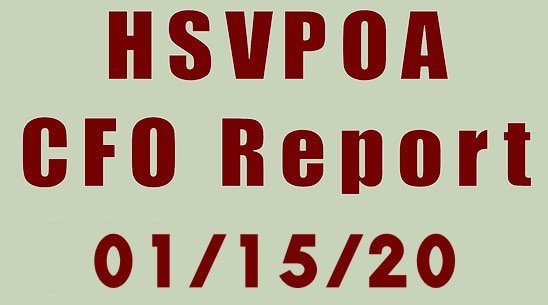The following is from the 1/15/20 Board meeting where the CFO/Corporate Treasurer presented the preliminary financials for 2019. CFO Mathis’ presentation immediately followed CEO Nalley’s presentation. If you haven’t already read it, you may want to click here to read the CEO’s report.
To the best of my ability, I have made every effort to accurately transcribe the following excerpt from the meeting. This section of the YouTube video may be viewed at the bottom of this article.
We pick up where Chairperson Erickson is receiving the CEO’s report as presented.
Erickson: “The Board receives the report as presented and we’ll turn now to Liz and deliver the Financial Report. Just a comment. Up here, I can hear a lot of chatter back in our guest area. If I could ask you to suppress that a bit. That would be helpful. Also, let’s allow Liz to get through her report and then I’ll open it up for questions. at the conclusion. How’s that?”
The report is preliminary – not final report
Mathis: “Thank you. We actually hit a lot of the bigger points of it already and giving you some of the details and results. Thank you, Lesley, for acknowledging that it was a pretty tight close turn. [Indecipherable]”
Mathis: “So, these are preliminary financial statements. We’ve made some estimates on areas where we won’t have final details for a little bit – in kind of our larger areas. So we’ll work to refine those numbers. But we try to take a pretty conservative approach to developing the preliminary financial reports.”
HSVPOA missed 2019 budget
Mathis: “Overall net excess (deficit) before depreciation increased $881,000 from the previous year and as Lesley talked about, we missed budget by $259,000.”
Seven divisions show increases – five are over budget
Mathis: “We did have seven divisions show increases, there was a word missing from my full summary there so, I apologize for that…show increases in revenue from the prior year. And five divisions that ended the year with revenues over budget. So that was kind of, of note. Four divisions showed decreased operating expenses and seven divisions show operating expenses under budget. So I am talking larger divisions, not individual departments. Lesley got into some of the more department level, so, which we will do in the upcoming reports.”
Some capital spending held in order to meet reserve goals
Mathis: “To offset this operation shortfall and ensure that we did meet those reserve goals, we did, as Lesley discussed, hold some capital spending. We did also have some savings in certain areas where projects came in under budget. And so we’re working through all of that and starting to develop a request that will come forward in a couple of months. Those year-end, kind of closing reconciliation reports to look at capital rollover in any area where we can roll stuff over. We did have some funds in the Street Division, in particular, that we very clearly budgeted to roll over operating funds from 2019 into 2020 and it was budgeted that way for 2020.”
Team worked hard to update renewal sales
Mathis: “Just a note, in this month’s packet, the very last page is a preliminary report of where we were at on annual renewal sales. As of December 31, our team is getting pretty caught up on those. I think we’re doing actual day’s mail that came in. For a while there we were working through the holidays and everything else to do updates of mail. But those are coming in really, really well. And in some areas, year-to-date numbers are already outpacing last year’s year-end numbers. So, we’re pleased to see that. And we’ll continue to provide this report over the next couple of months as those annual renewal passes come in and draw to a close for 2020. So looking forward a little bit there.”
Cash & cash equivalents intentionally decreased related to planned spending
Mathis: “On page two, just kind of want to point out and Diana you talked about some of this already. Our total cash and cash equivalents decreased $547,000 over the past year, which was related to some planned spending. But I just kind of want to go to reiterate, $522,000 of the $547,000 that we saw a decrease was the remaining bond funds that were for the wastewater projects for those not deferred maintenance and infrastructure improvements. So that was very intentional.”
Five year statute of limitations on delinquency write-offs
Mathis: “Lesley also talked a little bit about our write-offs. We do try to do that at year end every year per our policy that writes off the balance of any assessment amount over the five-year statute of limitations. That has always been accrued as bad debt over that five years. So, it really is a balance sheet adjustment and we were really pleased this year instead of having to get all of those accounts manually, we were able to develop a process to automate that, so that someone did not have to sit there and individually key each one of those write-offs. So that was a big process improvement for us that saved us a lot of time.”
Timing affects the numbers
Mathis: “Our long term debt has decreased $550,000 since this time last year and our overall liabilities have decreased $115,000. I kind of want to talk about the difference in that gap and why that is because looking at the balance sheet, I can see that our accounts payable and accrued expenses were a little bit different. I am kind of referring back to page seven. So if you are looking at the AP [Accounts Payable] and accrued expenses, those two lines in particular were a little bit higher than year and a lot of that is timing that has to do with [indecipherable] close and when we cut checks and how much had to be accrued because bills hadn’t come in and [indecipherable] some things like that. So, it is a shift, but a lot of that, when you see fluctuations in those two numbers, a lot of it has to do with timing and when, honestly, it’s sometimes when the day, the closing day of the month fell versus when we cut checks. So we cut checks on Wednesday and close the 31st was a Tuesday. So there was probably a lot sitting there that was about to get paid out the next day.”
Mathis talks about golf
Mathis: “We talked a little bit about some of the individual operating results through divisions so I am not going to go into a whole lot there. We’ll do more with those individual department reports. But I did want to talk a little bit about golf, just because I know Tom was really excited about December. In December rounds, we’re actually up just over 38,000 rounds over December rounds in 2018. So that was a pretty big boost at the end of the year. We did end the year-round, down rounds about 4,300 rounds. But in June, we were behind 14,000 rounds. So, we made up close to 10,000 rounds that we were down earlier in the year in the last six months of this year with some very nice December weather and we had lots of people out playing golf. It was great.”
Mathis: “Those are kind of the big highlights I wanted to hit. Obviously a lot more to come in the coming months as we close out the [indecipherable] year financials and we’ll have more detail on department level as well.”
Campagna discusses golf
Campagna: “Ready for a question?”
Mathis: “Yes, sir.”
Campagna: “Or a comment. When I look at the individual annual golf purchases, we are down a little at this point in 2019 but I think it is too early to tell. But I think the good news is these cash cards we bought dramatically, of course there was none, so wouldn’t be dramatic, they are up significantly more in the difference between the annuals being down. My anticipation is, we’ll maybe still see the annuals being what they are. But for all the people on the Board and anyone else that might be listening, an annual is a steal. It takes about 82 rounds if you own your own golf cart to break even. It used to be up in the 95 to 100 range. So, if anybody that is playing more than 1.6 times a week, should be buying an annual. That’s my pitch.”
Nalley: [Indecipherable]
Podawiltz discusses renewal packets
Podawiltz: “I have a couple of things. One, this came out of Let’s Talk last night.” Podawiltz talks about the fact that some Property Owners have not received their yearly packet in the mail with the new fee schedules and assessment rates.
Mathis said there were issues with the mailings this year and an outdated address list was used. This has now been corrected. If someone still hasn’t received this information, they can contact the POA administration office. Forms are also available online.
Red flag is waving
Podawiltz: “In regards to Operational Revenue, and I am referring to page three of Liz’s report if anyone would like to look. Operational Revenue was up $441,000. I am rounding here. And Operation Expenses were up a million, nine thousand. So for every dollar that we had in increased revenue, we spent an additional $2.30. That to me, I remember a little book about a train having problems and there was a red flag waving and I’ve used that many, many years. That is a giant red flag waving, in regards to business viability. And we are a business.”
CEO discusses how the dredging of Lake Balboa had an impact on expenses
Nalley: “Let me make one statement. Because I agree with that on one hand. The other side of that is, we dredged Lake Balboa, did we not? How much is that? Half a million dollars?”
Mathis: “It was $485,000 and we rolled that from prior years Operating Results into this year to pay for it, as a budgeted item.”
Nalley: “Yeah. So to some degree, absolutely, you’re on target with what we are looking at there, Diana. But to some degree we have to be careful of that assumption because Lake Balboa was a significant purchase.”
Podawiltz: “We need to footnote those types of items.”
Podawiltz discusses amenity fee timing
Podawiltz: “The other thing, I don’t know back to memberships being sold and I realize that this is through December and really that number will be far more telling when we get the ‘through January’ because most of this activity for buying, paying your amenity fees and buying your annuals and that sort of thing, does take place in January. Am I correct on that?”
Mathis: “It is through December and January.”
Podawiltz: “But most of your activity actually would take place, I mean we are seeing a picture here of through December. But most of your activity in that department, most of the revenue comes in during the month of January.”
Mathis: “For the annual passes, yes. But we spread it out over the twelve months. So you won’t see the rest of it…”
Podawiltz: “Yeah. But in terms of number of passes sold, not the revenue dollar amount. But the quantity.”
Mathis: “A lot of them are, yeah. It just depends on the timing of when people send their stuff in.”
Podawiltz: “Yeah. Because it’s…if I looked at this and said, ‘okay, you know I am seeing three pool memberships.’”
Mathis: “A lot of people may not buy a pool membership until the pool opens.”
Podawiltz: “Okay. Okay. Thank you.”
Mathis: “And we’ve had several people comment on that one in particular.”
Erickson discusses capital carryover
Erickson: “I think one thing, and you already talked to it, Lesley, with regard to this, capital carryover. It looks like, on page nine we had about $2.1 million in capital additions that weren’t spent. Right? At what point, and maybe you’ve answered this, but at what point will we begin to understand how much of that is by design? Because maybe we haven’t paid the last installment on the pool, let’s say. How much of it represents money that we budgeted, but turns out we didn’t need because we were effective in our negotiating and how much of it, most importantly, results from the fact that we just didn’t have the cash to be able to execute the capital projects? When will we know that, because reserves are driven by policy? There is a policy that says, ‘we must fund reserves.’ This is one of the very few places where we can meet that expectation, that policy expectation and still not…this isn’t driven by policy. So it can be detrimental to the association when we don’t expend the capital that we intend to do it. But it is one of our few levers when everything else has been [indecipherable]. So anyway, speak to that if you would, a bit more.”
Nalley: “So our practice in the past has been, in April, when you’ve heard from the auditors, basically. We are closed at this point. There is no doubt what it is. You will see that reconciliation there. Also, keep in mind, and Liz pointed out, on the balance sheet, that $2.7 million of accrued expenses and accounts payable. There may be some things that are timing issues that we’ve already accrued for. We don’t know that yet, but by April, you will have that clear picture. Each year we do that. So not only, that is the time when we say, you know what, as we went through the year, we actually, here is something we budgeted. Here was a capital item we budgeted for, but you know Jason Temple’s team found a better alternative and we are no longer going to spend that. So that money, either is additional money we can put into reserves or we may have identified something else that was more of a priority that April.”
Podawiltz asks if financial information will be available at the time the Board must make important decisons
Podawiltz: “Okay, so I’m trying to get my arms around this. So, we, this Board, will be asked to do, make the rollover decisions prior to seeing this in April?”
Nalley: “No, that’s not [indecipherable due to microphone being unconnected]. No, that’s when you will be asked. When you see it is when you’ll be asked to make the decision. In April.”
Podawiltz: “Okay.”
Nalley: “You won’t be asked to make that decision before you see the details.”
Podawiltz: “Okay. Thank you.”
Erickson asks how common it is to do a carryover due to ‘disappointments’
Erickson: “Can you characterize for us how often this circumstance happens year after year after year, where operating results are such that we find that we need to do some form of carryover because of disappointments. Has that, is that kind of a chronic situation? Is this unique here? Can you just put that in perspective for us?”
CEO states carryover happens every year
Nalley: “It happens every year. Every year we…I mean obviously we don’t have a crystal ball, so we set the budget in October and then we get into the year and we learn some things and things break down or don’t break down or whatever happens. We make those decisions every day. So it happens every day, all day long. When we get a better deal than we thought, that is more money that we can spend. So, it’s not unusual. This is the reconciliation of the year.”
Mathis discusses the impact utility bills have on rollover
Mathis: “I will say, one of the things that has really come to light for me, you know the more I go through this, but working on that accrual basis, we just accrued a month and a half of advanced revenue on the utility side. So that, a month and a half of revenue that we reported in December. But we don’t actually bill it until February. It won’t receive the cash from that until March. And so, to some extent, that plays a part in that flow a little bit, too. So we may always have some capital that we’re rolling over because it was budgeted with the revenue in a certain year but we may not receive it yet.”
Erickson, Campagna and Podawiltz would like to have earlier information – CEO states they are happy to provide this
Erickson: “So, I don’t know if others agree with me, on the Board, but it seems to me the earlier we know that, and with the greater clarity we know that, I think will be beneficial to the Board. You know, just exactly where each of those categories of capital rollover are going to play out. April…April seems very late. This Board, two of us are about to walk out the door and three more will be stepping in and if there’s an opportunity to do that earlier, even though, it may still be in a preliminary state, till the auditors get ahold of it, might be beneficial.”
Nalley: “And we are happy to do that. Previous Boards have not wanted to make that decision until they were assured the results were final and until…And we will be actually closing the year, through February. Just making sure, through March, we may still be getting invoices. Each year we attempt to and…Liz is doing a phenomenal job of getting her AP processes aligned and identifying the people who are waiting too long to bill us and getting that straightened out. But from a billing standpoint, from our vendors, also, our own utility revenue billing procedures right now…we’re not billing until a month and a half after we close. So there are several factors that say we can give it to. We can give you any…today, we could give you best guess – with what we know today. What we prefer to do, is to wait until there is no guess and it is final. So you all can make that decision if you want it sooner.”
Erickson: “Right. I am not advocating for an earlier decision. I am advocating for earlier visibility.”
Mathis: “Say that utility billing doesn’t finish until February 28. So we’re still making adjustments, as of that time.”
Campagna: “How much water we bill [indecipherable], versus history in dollars on those months that aren’t billed? Particularly, we’re talking about December, I guess, mostly, can’t vary very much from one year to the next. So every year, I assume..
Nalley: “That’s not true.”
Campagna: “Vary $50,000? Okay, I don’t call that much in the grander scheme of how much we bill. So given that, every year we must have to accrue because we’ve got this situation every year and when you are accruing from one year and you are doing it every year, eventually it balances out and it shouldn’t make that much overall difference in putting the numbers together, it seems to me.”
Nalley: “As I said, we can give you numbers tomorrow with what we know today. So, to the point, we can give it to you any time you want us to with best known information at that time and we can also identify, ‘and here are the unknowns.’ Right.”
Campagna: “In one respect, I’d like to have those numbers and I think Cindi would also.”
Podawiltz: “And so would I.”
Campagna: “And so would Diana. Every month of the year, we had this bottom line on the report that showed how much we expected to fund the reserves with or have left to fund reserves with. At this point, most of the year has a forecast. At this point, actually it’s a lot closer to probably reality because we may not have all the numbers in, but we’re a lot closer. It’s not a guess on how many rounds of golf we’re going to do or how much we’re going to do in a lot of areas. It seems to be that much, it could be pretty accurate. And it would also be pretty telling of how really did.”
Nalley: “It will be by the end of February. I would say, not will be 100% accurate. It would be more accurate when we run that billing and when we have completed, we’ve made sure that we’ve received most of our AP invoices.”
Podawiltz: “I just…”
Erickson: “Diana, please don’t interrupt. Let her finish her comment.”
Podiawiltz: “I thought she was finished. I am sorry.”
Nalley: “Anyway, when we feel like we’ve received most of our invoices and when we’ve completed our billings.”
Mathis: “I just want to say one other thing though. When we’re looking at funding reserves, that utility billing and receiving those utility funds; they don’t come in until March. So the cash from that revenue is not in the bank to move into reserves until March. So, that’s another part. We can look at it earlier, but we probably wouldn’t be able to make the move until those funds are received and there is a balance in that as well.”
Erickson: “Okay, Diana.”
Podawiltz: “I understand that, but we’ve got to have a look-see behind the door on this reserve number, whether it is the total final number or not because there are other decisions that we have to make that are based upon that number; because it is an enterprise goal.”
Campagna: “And what you are describing is a cash flow issue – not necessarily how much we are going to physically stick in the bank. You can’t stick the money in the bank until you got it. That’s for sure.”
Nalley: “That’s right.”
Campagna: “But, you can surely understand, assuming that the bottom doesn’t fall out, that when that cash flow comes in, you can now stuff the money into your savings account.”
Podawiltz: “I mean that’s a receivable that’s sitting out there; that’s what you’ve got. But your baby, we as a Board, have decisions we have to make based on that receivable amount.”
Nalley: “And let me just say, I think both Liz and I have said, already, we have every confidence that those reserves, that that reserve, I think it is $58,000 – that’s what we’re talking about here.”
Campagna: “What was that again?”
Nalley: “Fifty-eight thousand dollars. That’s what we’re talking about. There’s no doubt we’re going to fund that. The question remains, of the two million unspent capital funds, what are we saying is rolling over versus, we got to pull it back off because we missed operational results. Right? Or we got to rebudget it. So no concerns whatsoever with either one of us that we’ll fund reserves.”
Erickson: “Okay, good. That’s good to hear. What I am hearing is, and I don’t know Mike and Buddy if you want to weigh in on this, but what I am hearing is a general consensus that we would like, albeit preliminary, an early look at that even before April. Right? Okay. Very good.”
Higher actual numbers than estimated for provision for bad debt
Erikson: “Could you speak a little bit, another number, another line that catches my attention on line eight, is, or excuse me, page eight, the provision for future bad debt. Our estimate was far less than what we actually experienced. What were the driving factors there?”
Nalley: “I can speak to you. And I think actually I have spoken on this a couple of times already in Board meetings. We anticipated a much larger recovery on one of our lawsuits than what occurred. So we hedged our bets slightly on that. That didn’t pan out this year. And so we are no longer hedging our bet. We are calling that spade a spade and acting accordingly.”
Podawiltz: “That tripped a…I don’t know where I wrote it down, but I wrote it down. But anyway, in the, on looking at the balance sheet. What page is the balance sheet? Balance sheet on page seven and the allowance for doubtful accounts. You were talking about the bad debt write-off this year of 4.9 million and you mentioned that following the statute of limitations, if it hits five years, we write it off. Is there a way to find out how much of this 15 plus million we are carrying for allowance for doubtful accounts is entering into it’s fifth year?”
Mathis: “Yeah, we can start to look at that number. It doesn’t roll into that category in the ending report until December, but…”
Podawiltz: “I understand.”
Mathis: “But yeah, I mean if…”
Podawiltz: “Because…”
Mathis: “We’ve already accrued everything over. So as far as our bad debt accrual, we’ve accrued and expensed the bad debt for anything over one year.”
Podawiltz: “I understand. But I was just seeing whether the Board could be able to have a better view into what we’re likely to write off in 2020 and what that aging report actually looks like.”
Nalley: “So, I think there’s some information here that we could get you the exact details, but I think there’s already some information here that’s gonna tell you our future. Every year, every year we, we said in here, there’s about 3.9 million dollars. Right? That’s the true number, so every year we’re going to be accruing right now, as long as we have those seven thousand homes, or seven thousand unimproved lots. As long as we have that problem, 3.9 million a year is going to be the number, you’re going to write off, potentially every year. Thats, until we solve that assessment issue.”
Podawiltz: “Well eventually they get written off though.”
Nalley: “That’s right.”
Podawiltz: “They get written off.”
Nalley: “But you add some back and you write it off so the balance doesn’t really go down.”
Campagna: “Is it seven thousand lots or [indecipherable]? Are we accruing for the money of the lots we own that don’t pay?”
Nalley: “Well, the reason I said seven thousand is that seems to be, as I did my analysis, that seems to be the number that is multiple years past due. Right? So they’re not current and we can expect they’re not gonna be. There are seven thousand or so lots. That’s also about the number that is at the Commissioner of State Land. So they are also not paying their taxes. That seven thousand number is our Achilles heel there.”
Podawiltz: “But eventually they get written, that big bulk gets written off. That big bulk is sitting in the $15 million number.”
Campagna: “I don’t think so Diana, because it would seem to me that if I had, if I’m going to use what’s over 60 days or whatever the criteria uses, even though I am writing off this period of time from I am not paying for, I’m going to be adding more back into the back end that’s going to keep moving the ball forward. So it basically if the lots stay stable that didn’t pay, that number would always be the exact same number every year that didn’t pay, minus whatever the fees went up.”
Nalley: “That is right, because you still have, you know, four years of their bad debt is still on your books. And you’re always just rolling one year for those people until you make…Because the one thing we won’t do is, we won’t stop assessing them, according to our declaration.”
Podawiltz: “Until five years have passed.”
Nalley: “Well, we’ll never stop assessing them. We’re just writing off. That’s right. Because our declaration, you know, it’s still an obligation. So until we solve the seven thousand problem…”
Podawiltz: “So we’re carrying three point, we’re saying we’re likely to write off 3.9, 4 million every year. This year it is closer to 5 million. I am just saying that if we had an opportunity to see how much of this 15 million was already entering into it’s fifth year, that would give us a good inclination of what our actual write-off is possibly going to be for 2020.”
Nalley: “It will be about the same. I mean, it’s going to be 3 to 4 million dollars.”
Podawiltz: “Well, there is a difference between…”
Mathis: “Let me just say, one of the things we are looking at here is that August of 2020, will actually be five years on this software system. So right now we’re having to calculate the write-off amount manually because it’s not actually showing up a five-year column on my aging report. So once we get to August of 2020, it will start showing up in that column and it will be something really, really easy to report. So if we still feel like we need a better deep dive then…”
Podawiltz: “I look forward to August. Thank you.”
Revenue per day or revenue per playable course day?
Erickson: “I had another couple of comments. One on page four, back to golf. It’s just a comment, not a question. There’s a line there called revenue per day. I think more accurately it’s revenue per playable course day. Is that not correct?”
[It sounded like someone faintly said ‘yes’.]
Erickson: “I think it’s a metric that we ought to all keep our eye closely on and the fact that it went down this year. That whole idea of having playable course days as the denominator was intended to be kind of a rough elimination of the effect of weather on our revenue. Right? So, in a perfect world, if weather was the same or even if it wasn’t, that math should indicate whether our assets, our biggest assets which are golf courses are generating the revenue needed. So the fact that that went down this year speaks to me to be a problem and I just applaud every effort that we take to try to turn that around. Maximize the revenue. Weather – we can’t do anything about, but that’s a key metric I think to keep an eye on and we would hope year-over-year it would go up and I think it’s budgeted to go up. So we need to stay focused on that.”
Food and Beverage
Erickson: “Finally on Food and Beverage you made a comment that you’re doing a deeper dive on Food and Beverage, that too in the aggregate, had some disappointing results for this year. What can you tell us about some of the things that you are looking at in Food and Beverage? Are you prepared to speak to that at all?”
Nalley: “So not completely prepared to talk about all of the different things we are putting out on the table in terms, as we know, our nuclear option would be close down the Food and Beverage operations. That would cure the subsidy. That would cause us some issues on the other side and so that’s not the option that we’re looking at.”
Nalley: “We would much prefer, I believe, the POA would much prefer not to be in any of these types of businesses where someone else, an entrepreneur, can be successful. So other options are how do we encourage entrepreneurship on what is a very challenging restaurant model? Golf course restaurants are very challenging. So how do we encourage people to take on those risks and those challenges? And take that from us? That’s a small pool of folks, but certainly, that’s what we’re looking at. On the flip side, I think that our team has made a tremendous effort in the last half of 2019 to really focus our attention on banquet sales and some of our high-traffic times. We don’t want to lose the service aspect of there being food and beverage offerings on our golf courses. We think not having them will completely crash…it would do just the opposite on that revenue for playable days number that you are talking about on golf. So what we foresee is a better balancing of the POA doing what it can do well and someone else doing what we can’t do well. And until that someone else presents themselves, then we will continue doing our best to move those metrics. I think that in a nutshell.”
Campagna: “So what I thought I heard you say is that we are looking or we’d be hopeful if some third party took over one or more of our restaurants. Which I think would be great if they did and they’d have to obviously assume that their financial model would make sense or they wouldn’t do it. But I thought I heard you say that you’re looking at some people. When I was in sales, there were two classes of customers…potential customers. Suspects who respond to the bingo card and prospects who actually thought that they might have a need for whatever I was selling or I could convince them they had a need. So, as I look at that, do we actually without you telling me who, what or where, do we have anybody beyond “suspects”. “Suspects” could be Chili’s or Olive Garden, which I doubt they’d do it, but do we have any?”
Nalley: “We are, we are talking to some individuals but one of the steps that we’re going to take is to take a, actually take an RFP approach to this process. During the facility evaluation process that we are also doing, we’re going to take an opportunity to look at, as you know one of the reasons why it’s challenging, in our operation is because the kitchen is not set up to be a full-service restaurant. The kitchens are set up to be a golf course grill and frankly, nobody makes money at that. So we need to be honest with people about what facility exists or what it would take to transform it into something else. You mentioned about the third party. Third parties don’t always save us money. When Marriott was here, it cost us $500,000 a year. It didn’t touch the subsidy. So we don’t want to do another scenario where basically somebody else is still, somebody else is still making the money and we’re footing the bill.”
Campagna: “Well that is probably the Marriott case, though, based upon the way we wrote the contract.”
Nalley: “Well, there were two different, Marriott and someone else. And this was, of course, years ago, but, yes, I think the expectation that our food costs. I mean that our food pricing remains very low in this community. There’s a certain set of customer expectations and unfortunately, you’re not going, at a golf grill, you’re not going to make a ton of money.”
Campagna: “It’s interesting, though, I hear all the time that we don’t want to spend a lot of money. But I don’t think the 501 Prime [Indecipherable} are going out of business. At least it doesn’t look like it.”
Nalley: “Now you’re not…”
Podawiltz: “All I can say is that Friday evening we went to dinner at Granada Grill and I had the lovely four-ounce filet with mushrooms on it and some kind of sauce, mashed potatoes, and I even ate my carrots. And it was a wonderful meal and it was less than $20. I mean, we are not overpriced in these restaurants and we are putting out a very quality product. Our residents need to be taking advantage of that, especially during these winter months and not drive into Hot Springs and go to 501 Prime.”
Erickson: “Very good. Thank you very much. Okay. Anything else for the CFO report. That was a good thorough discussion. I appreciate that, Liz and the extra effort you and your team put in to get us this report in a timely fashion. Thank you so much.”
Erickson: “So the Board receives that report as submitted.”
HSV Preliminary Financials – Written report from the CFO, Liz Mathis, January 15, 2020
7December-2019-Preliminary-Financial-PacketClick here to watch the video of the CFO’s presentation on 1/15/20
Transcribed by Cheryl Dowden
Be sure to bookmark this website so you don’t miss any new articles.











Moe
01/23/2020 — 5:29 pm
Well, you heard the mandate. Get out there and eat at the course restaurants. Don’t drive to Hot Springs.
Ok, let’s make sure that happens.
Problem solved.
Minn Daly
01/23/2020 — 5:48 pm
Restaurants in HSV in dire straits! Oh, wasn’t it the BOD/CEO with local realtors as guests, celebrate the New vision of working with local realtors after the close of HSV Real Estate office @ a private owned facility within HSV instead of useing DESOTO CLUB earlier this month. Why didn’t they support HSV owned establishment? Cost of this luncheon would have been a very good benefit to DeSoto Clubs Financial report. Minn Daly
Tom Blakeman
01/23/2020 — 6:39 pm
Ya know, I’m all for supporting Village restaurants. I enjoy and try to support the one on the golf course near me. But the fact is that we do not need the number of establishments (POA or private) that currently exist inside the Village gates. In fact many of those just outside the gates who have started up in the past couldn’t make it either.
Furthermore, while it may be necessary to subsidize some services needed here in HSV, such as ambulance service for example, it is beyond ridiculous to think we need to subsidize restaurants. And, most of all the argument that we used to subsidize them more than we currently do, so subsidizing them now is OK is totally insane
All we really need the POA to operate is a snack bar – maybe a vending machine- at each golf course and – maybe – one other facility such as the Desoto club for events. Otherwise we need to be out of the restaurant business. Totally out. We can’t afford it.
Having said that, if we really think that we need restaurants operated or subsidized by POA then we need to prohibit private restaurants inside the gates. That’s right, shut down Bee Hive, El Jimador, Xplore Lakeside, Debras, Dolce Vita and any others like that. There is way too much competition already. And, by the way, some of those establishments, like El Jimador for example, actually know how to run a profitable business. POA does not.
And if the snack bars can’t make a profit then they need to be shut down too. What we have here is no different that our US Government subsidizing everything under the sun, including foreign 3rd world countries, because it is politically rewarding for the politicians. Meanwhile our US Government is going broke just like POA.
Moe
01/24/2020 — 5:48 am
I wonder if they subsidize restaurants in other communities, such as Sun City.
Me thinks not.
Adonna lovehsv
01/23/2020 — 10:08 pm
Thank you for all the hard work done here and in the past.
Excellent information for those who are interested.
We are going stronger.
The truth needs to be heard.
George
01/23/2020 — 10:31 pm
Tom,
There is a lot of truth in what you say. These course restaurants were not intended to be full service restaurants, kitchens and layouts are not set up for it. DeSoto should be, but it lacks something to drive people there. They should be scaled back to see if they can be profitable. 7 months of a new CMEO and I see no apparent improvement. Would really like to see her 2020 objectives!
All of Nalley’s banter about capital carryover shows her ineptitude about capital budgeting and execution. Never heard this type of discussion from our corporate management when I worked. It is truly disheartening to read her explanation.
And playable days vs days. If the courses are open, we are paying people. Rounds of golf year over year are all that drive our profit and expenses. Barring disasters like tornadoes, they should not muddy the numbers with a subjective statistic.
And all the talk about timing, annual fees, etc. why not move the fiscal year to 2nd or 3rd quarter. Sounds like it would help a lot of the planning and reporting. Companies do it.
Moe
01/24/2020 — 5:16 am
What would help most in the accounting and planning areas would be to have competent people doing the accounting and panning.
steve bylow
01/25/2020 — 12:22 pm
Thanks for the great article.
In regard to restaurant management – the fact that a successful business like Tanners left Granada years ago is a simple example of poor POA Leadership.
The Tanners departure was actually one of the first “red flags” that POA leadership lacked judgment.
Little did I know it was the tip of iceberg.